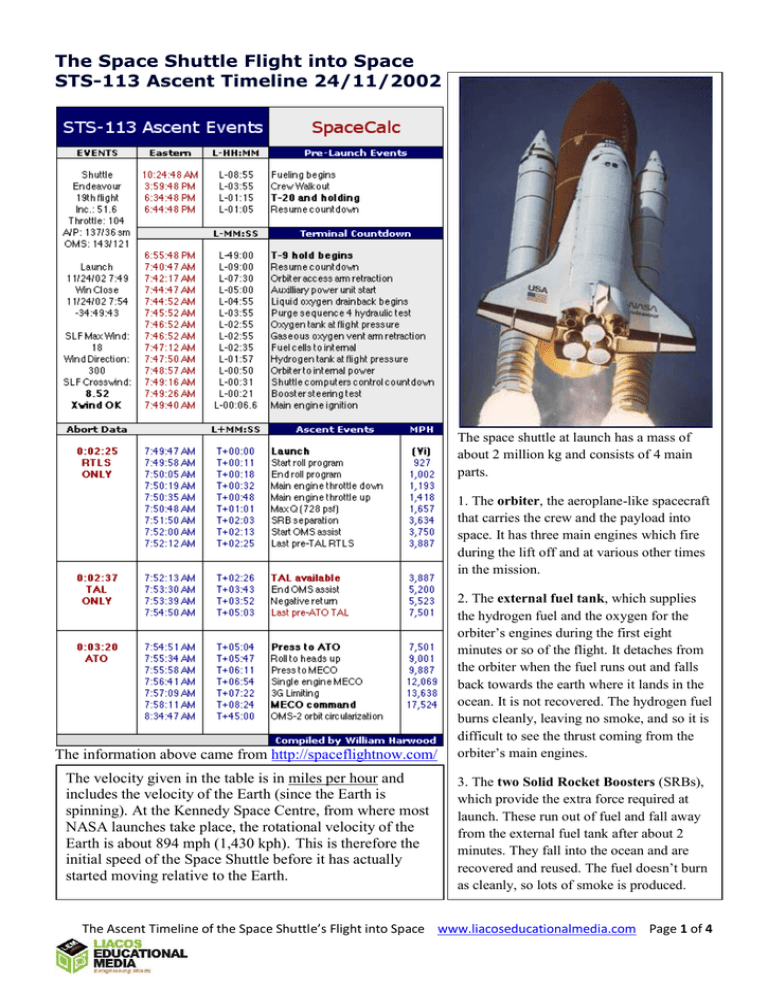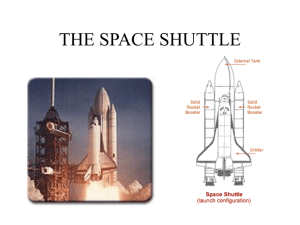The Space Shuttle Flight into Space STS-113 Ascent Timeline 24/11/2002
advertisement

The Space Shuttle Flight into Space
STS-113 Ascent Timeline 24/11/2002
The space shuttle at launch has a mass of
about 2 million kg and consists of 4 main
parts.
1. The orbiter, the aeroplane-like spacecraft
that carries the crew and the payload into
space. It has three main engines which fire
during the lift off and at various other times
in the mission.
The information above came from http://spaceflightnow.com/
The velocity given in the table is in miles per hour and
includes the velocity of the Earth (since the Earth is
spinning). At the Kennedy Space Centre, from where most
NASA launches take place, the rotational velocity of the
Earth is about 894 mph (1,430 kph). This is therefore the
initial speed of the Space Shuttle before it has actually
started moving relative to the Earth.
2. The external fuel tank, which supplies
the hydrogen fuel and the oxygen for the
orbiter’s engines during the first eight
minutes or so of the flight. It detaches from
the orbiter when the fuel runs out and falls
back towards the earth where it lands in the
ocean. It is not recovered. The hydrogen fuel
burns cleanly, leaving no smoke, and so it is
difficult to see the thrust coming from the
orbiter’s main engines.
3. The two Solid Rocket Boosters (SRBs),
which provide the extra force required at
launch. These run out of fuel and fall away
from the external fuel tank after about 2
minutes. They fall into the ocean and are
recovered and reused. The fuel doesn’t burn
as cleanly, so lots of smoke is produced.
The Ascent Timeline of the Space Shuttle’s Flight into Space www.liacoseducationalmedia.com Page 1 of 4
YOUR MISSION: To produce a speed vs time graph for the ascent stage of a Space Shuttle.
Using Excel and the data on Page 1 above (which has already been typed out for you below), you are to
create an annotated Speed vs Time graph (with speed on the y-axis and time on the x-axis) for the Space
Shuttle’s Ascent, that is from Launch until its Main Engine Cut Off (MECO) when it has reached space
about 8½ minutes later. You will annotate the graph with five text boxes which contain information
about events that take place during the ascent; for example, SRB separation at 2 minutes and 3 seconds
after launch. (See an example of an annotated graph on page 4.)
You will need to follow the instructions carefully.
Time
Speed in
into
mission
MPH
0:00:00
894
0:00:11
927
0:00:18
1,002
0:00:32
1,193
0:00:48
1,418
0:01:01
1,657
0:02:03
3,634
0:02:13
3,750
0:02:25
3,887
0:02:26
3,887
0:03:43
5,200
0:03:52
5,523
0:05:03
7,501
0:05:04
7,601
0:05:47
9,001
0:06:11
9,887
0:06:54
12,069
0:07:22
13,638
0:08:24
17,524
1.
Create a table in Excel showing
(i)
Time into mission
(ii)
Speed in Miles per Hour
(iii)
Speed in Kilometres per hour (mph x 1.6).
To do this the easy way,
(a) click on the box next to the “894”
(b)
type “=”, click the 894 box (cell B2) and
then type “*1.6”.
When you press Enter, the value should appear.
(c)
Click and hold the small elbow of the box
and drag down the table. This performs a “fill
down” operation (C2*1.6, D2*1.6 etc.) and all the
values then appear automatically.
(d)
Put a border around the table and highlight the headings. You may need to
use the “Merge and Centre” button and the “Wrap Text” button (both on the Home
Tab) to format the text.
The data in the time column should to be formatted to Hours:Minutes:Seconds. To do this…
Highlight the cells: Right click: Format Cells: Number Tab: Custom: h:mm:ss
It should look something like this.
2. Draw a graph of the
information with time on the
x axis (the horizontal axis)
and speed in kilometres per
hour on the y axis (the
vertical axis). (See below for
instructions)
To draw a graph…
Step 1. Click on an empty cell
at least two cells away from
the table.
Step 2. Click Insert…Scatter…
Scatter with Smooth Lines
and Markers.
Step 3. You should see a blank area where
the graph will go.
Click Select Data on the Menu. A dialogue
box will open.
The Ascent Timeline of the Space Shuttle’s Flight into Space www.liacoseducationalmedia.com Page 2 of 4
Step 4. Click the Add button.
This allows you to tell the computer what
data you want on the x-axis and what data
you want on the y-axis.
Step 4. Highlight the data you want to graph on
the X axis (in this case, TIME). You will see
something like “=Sheet1!$A$1:$A$3” .
Highlight only the numbers, not the headings!
A similar operation is performed for the data you
want on the Y axis (in this case SPEED in
KM/HR.) (you need to delete the “={1}” that
appears.
Click OK, and a graph should appear.
Step 5. If the time axis shows unusual numbers
you will need to change the formatting so that the
graph show increments in minutes. To do this,
(i) right click the numbers
(ii) click “Format Axis”.
(iii) In “Axis Options”, type 0.000694 in the
“Major” Units box. This is the fraction that 1
minute takes up of one day: 1/(24x60).
(If your time was written, for example, as 8:24,
Excel is likely to format the cell as HH:MM—hours
and minutes—so you may need to type in
0.0416666, which is 1/24.)
Step 6. It should now look something like this.
Click either, Add Chart Elements, or the + sign
next to the graph and add a “Chart Title” and
“Axis Titles”.
Format the graph to taste.
Ensure the graph takes up 1 whole page. Use View:
Page Layout. You may like to copy the graph into
Word and then re-size it.
3. Add some pictures and 5 small text boxes to the
graph to provide information in your own words about
some major events that occur on the shuttle’s flight to
space. The information below might be helpful. An
example of an annotated graph is also shown below.
4. Answer the following questions in full sentences.
(a) At what time (with respect to the launch) does the fuelling of the fuel tank begin?
(b) At what time (with respect to the launch) does the access arm from the tower retract?
(c) At what time (with respect to the launch) do the orbiter’s main engines ignite?
(d) At T+03:52, the shuttle is “Negative return”. What does this mean?
(e) How fast is the shuttle travelling when it reaches space and its engines are switched off?
(f) Comment on the shape of the graph and what it shows.
The Ascent Timeline of the Space Shuttle’s Flight into Space www.liacoseducationalmedia.com Page 3 of 4
(g) How fast is the shuttle travelling at the (i) 3-minute mark? (ii) 4-minute mark? (iii) 5-minute
mark? (iv) 6-minute mark? (v) 7-minute mark? (vi) MECO command.
(h) What is the difference in speed between the 3-minute mark and the 4-minute mark?
(i) What is the difference in speed between the 6-minute mark and the 7-minute mark?
(j) The Space Shuttle’s speed is obviously increasing. What is happening to the Shuttle’s
acceleration (which is the change in speed per unit of time)? Explain why.
5. Write your name on your work and submit it.
An explanation of some of the events that take occur during a shuttle’s ascent.
(written by William Harwood http://spaceflightnow.com/)
T+0:11
Start roll maneuver
Endeavour begins a programmed roll maneuver to achieve a northeasterly track from KSC, heading
toward a 51.6 degree inclination to the equator.
T+0:18
End roll
The shuttle completes the programmed roll maneuver and is now positioned heads down, wings level.
T+0:32
Start throttle down
The three liquid-fueled main engines are throttled down to ease the vehicle's flight through the dense
lower atmosphere.
T+0:48
Throttle up
Endeavour's main engines begin throttling back up to about full thrust for the continued trek to space.
T+1:01
Max-Q
The shuttle passes through the area of maximum aerodynamic pressure that is experienced during its
climb to orbit.
T+2:03
SRB staging
Having consumed all their propellant, the solid rocket boosters are jettisoned from the attachment points
on the external fuel tank. The boosters parachute into the Atlantic Ocean for recovery and reuse.
T+3:52
Negative return
Endeavour is now too far downrange and traveling too fast to make an emergency Return-to-Launch-Site
abort landing at Kennedy Space Center. A problem after this point during flight requiring an abort would
lead to a Trans-Atlantic Abort Landing, Abort-to-Orbit or Abort-Once-Around.
T+5:47
Rolls to heads up
A programmed maneuver rolls Endeavour to a heads up position, placing the shuttle atop the external
tank. This is done to improve communications between the shuttle and NASA's orbiting Tracking and
Data Relay Satellite System.
T+8:24
MECO command (Main Engine Cut Off)
Endeavour's three main engines are shut down. The external fuel tank is jettisoned moments later. An
upcoming firing at about T+45 minutes by the Orbital Maneuvering System (OMS) engines will boost the
shuttle from its current sub-orbital trajectory to a safe altitude as the chase begins to rendezvous with the
International Space Station.
(An annotated graph can look something like this)
Source: http://www.investmentpostcards.com/2010/04/01/q1-globalstock-market-performance-in-review/
The Ascent Timeline of the Space Shuttle’s Flight into Space www.liacoseducationalmedia.com Page 4 of 4

